Best flowering variegated plants
Add highlights and low-lights with the best flowering plants with variegated foliage.
As if nature didn’t offer sufficient variations in colour size, shape and style of plants, there is the additional choice of leaves that are variegated. They usually offer two or more colours in one leaf, most often a green leaf with paler highlights, but occasionally, there are plants that have leaves with a dark variegation.

I like to grow a combination of the all green leaves and the variegated leaves variety of the same plant, often side by side, to enhance the differences in each other. Variegated leaves tend to perform best in full light. There is a potential for leaves to revert to all green if they have low light levels or if the plant is stressed e.g. extremes of temperature. There are exceptions, of course, but that’s the wonderful thing about nature.
Variegated leaves are a great way ‘lift’ a dull area and to continue adding interest to a border even when the plant is not in flower. Here are some of my favourite plants with variegated leaves that provide a good display and I have found easy to grow.
Nasturtium ‘Alaska Mixed’

I grew this Nasturtium ‘Alaska mixed’ variety for the first time in 2023 and was delighted with its performance. Like all nasturtiums, it required almost no attention and flowered nicely from summer until the first heavy frost. The leaves are mottled and splashed with cream and the flowers, for the most part, are held above the foliage. I like to start them in pots to plant out when they have five or six leaves and I use them to fill gaps in beds and borders and I allow them to scramble across paths and up fences. They are ideal for attracting butterflies, so make sure you plant them away from brassicas.
Acer platanoides “Drummondii”
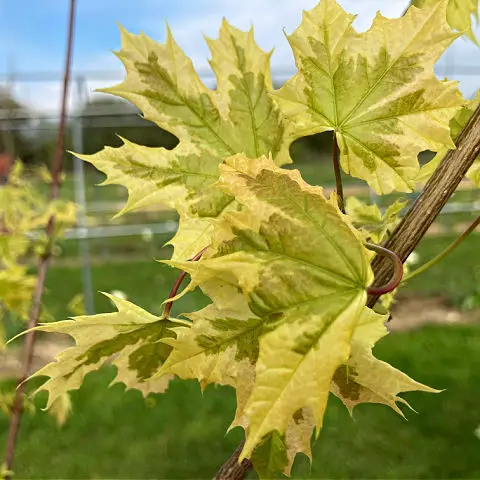
The leaves of Acer Drumondii are light to mid green with wide cream edges. As it matures, more of each leaf is green, but they still have a cream edge. The pale yellow flowers, which are often unnoticed, appear in spring before the leaves. It is ideal for a medium to large garden. Eventual height and spread are 12 metres. They are fast growing, forming a rounded head and are easy to maintain. If you do need to prune dead or crossing branches, do so during the winter while with tree is dormant.
Iris pallida ‘Argentea Variegata’
As if irises didn’t already add plenty to the garden, along comes a variety with variegated leaves! These semi-evergreen plants have survived some very cold and wet weather on our north-facing hillside and are still thriving. They prefer sandy and loam soils that are neutral to acid, in full sun. During the summer, fragrant light purple flowers are borne on upright stems. Height 9ocm and spread 30cm. Propagate by division in late summer or early autumn.
Geranium phaeum var. phaeum ‘Samobor’

Of all the hardy geraniums, I prefer the phaeum varieties, with their early flowers held above the mound of foliage. I grow both a white variety and a couple of very dark purple, with petals so dark that they appear almost black. Imagine my delight when a gardener gave me a small clump Geranium phaeum ‘Samobor’, with mid-green leaves that carry brown low-lights. I consider this one of the best flowering variegated plants. If you continue to deadhead this plant, it will flower for weeks offering a good display in its own right, as well as providing a good foil star plants like peonies, oriental poppies and early roses. It grows to 60cm height and 40cm width. To prevent the centre becoming overcrowded and dying, lift and divide every three to four years, replanting the younger, most vigorous sections.
Lysimachia punctata ‘Alexander’
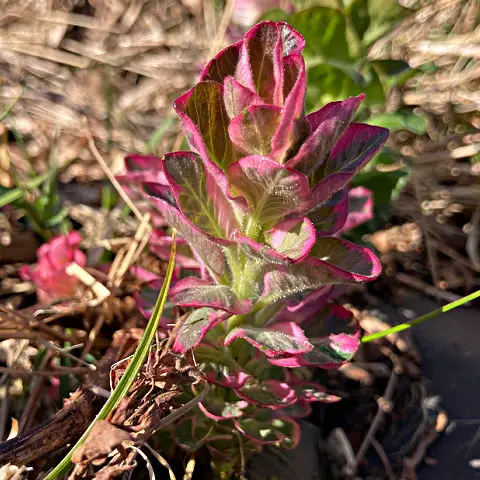
This variegated strain of Loosestrife has pink blushed foliage in spring. It is a vigorous grower and will quickly form a large clump. During the summer intense yellow flowers appear at the leaf axils giving a strong display of colour in the border. It is happy in full sun and partial shade and prefers moist, but well-drained loam or clay soils. It will also grow in boggy areas if you keep the crown above water level. Height 60-90cm and 60cm spread. Propagate by division in spring or autumn.
Lunaria annua var. albiflora ‘Alba Variegata’ (v)
Honesty has so much going for it. The pretty purple, or white, flowers appear in late spring, followed by attractive seed pods that open to reveal the seeds against a silvery disc. The variegation of Lunaria annua ‘Alba Variegata’ provides a splash of creamy white. The leaves are pale with a green central section and they contrast nicely against the rich purple of the flowers. This biennial grows to 60cm height and 50cm spread. It will self-seed readily or collect the seeds and grow in pots to plant out during the first year. Honesty grows happily in all, but clay, soils and is hardy across the UK.
Variegated Thyme

I include a variegated thyme in a lot of my ‘favourite’ lists, and for good reason. It is a low-growing, evergreen perennial that provides excellent ground cover and is good for culinary usage. The tiny flowers are fairly insignificant individually, but clustered together on top of the purple stems, they attract pollinators and provide an additional splash of colour on an already interesting plant. They may not survive in heavy clay or waterlogged soil and prefer a well-draining position in full sun.
Pelargonium ‘Mrs. Pollock’
Like many zonal pelargoniums, ‘Mrs Pollock’ has dark purple-red markings as well as a yellowy-cream edge to each leaf. They produce bright scarlet flowers held on stems well above the foliage. Pelargoniums are evergreen, but tender plants. They require protection from cold and frost, so should be put in containers and protected from before the first frosts until after all risk of frost has passed. During winter, water sparingly and allow the compost to dry out between waterings. To propagate, take cuttings from spring to autumn. For colour variation, I think this is one of the best flowering variegated plants.
Kale Daubenton’s variegata
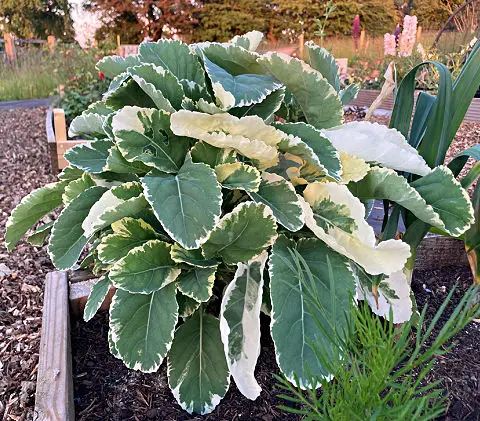
Of all the perennial kales, I think this is the most attractive. It is easy to grow from cuttings, even during the winter months and grows into a mound of green leaves edged with cream and occasionally almost an entire leaf may be cream. Height and spread 100cm. Harvest leaves of this perennial vegetable, rather than lifting the entire plant, throughout the year for a tasty addition to the kitchen. Plants live up to 8 years and are hardy across the UK in all but the most severe winters.
Lamium maculatum ‘Pink Pewter’
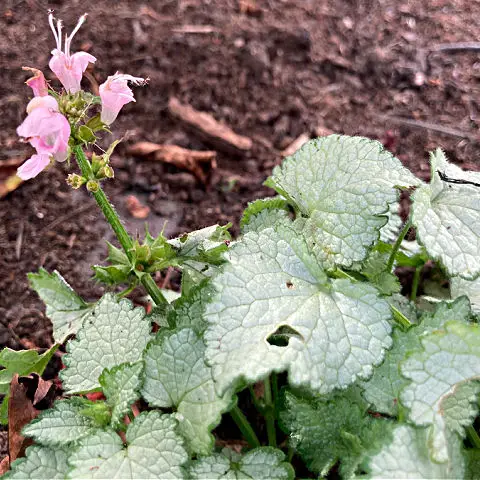
A silver and green leaved evergreen ground cover plant with pink flowers. A low-growing plant that spreads to 45cm and produces pale pink flowers from summer to early autumn.
Ageratina altissima ‘Chocolate’
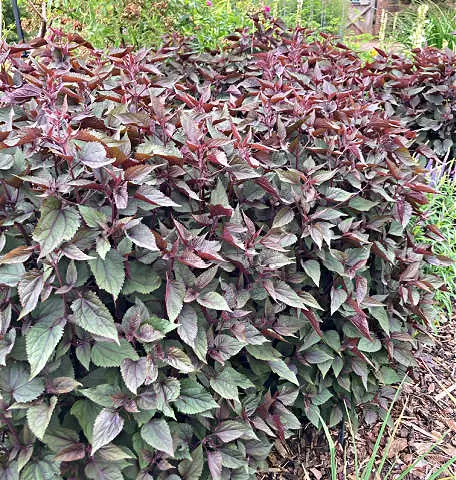
And although its not strictly a variegated leaf, the purple-brown new growth, the underside and ribs of more mature leaves of Ageratina altissima ‘Chocolate’ certainly add a splash of low-lights in the garden.
More information
The article, Best flowering variegated plants, was written originally for Amateur Gardening magazine in late winter 2025. I have updated some of the specific varieties and images, I have added further plants to the list and I’ve included to help you find the suggested plants. For additional leaf interest in your garden, try some great plants with pink leaves.
- Protected: Urban back garden - August 28, 2025
- White garden in early summer - August 28, 2025
- Classic Cottage Garden Plants - August 15, 2025
